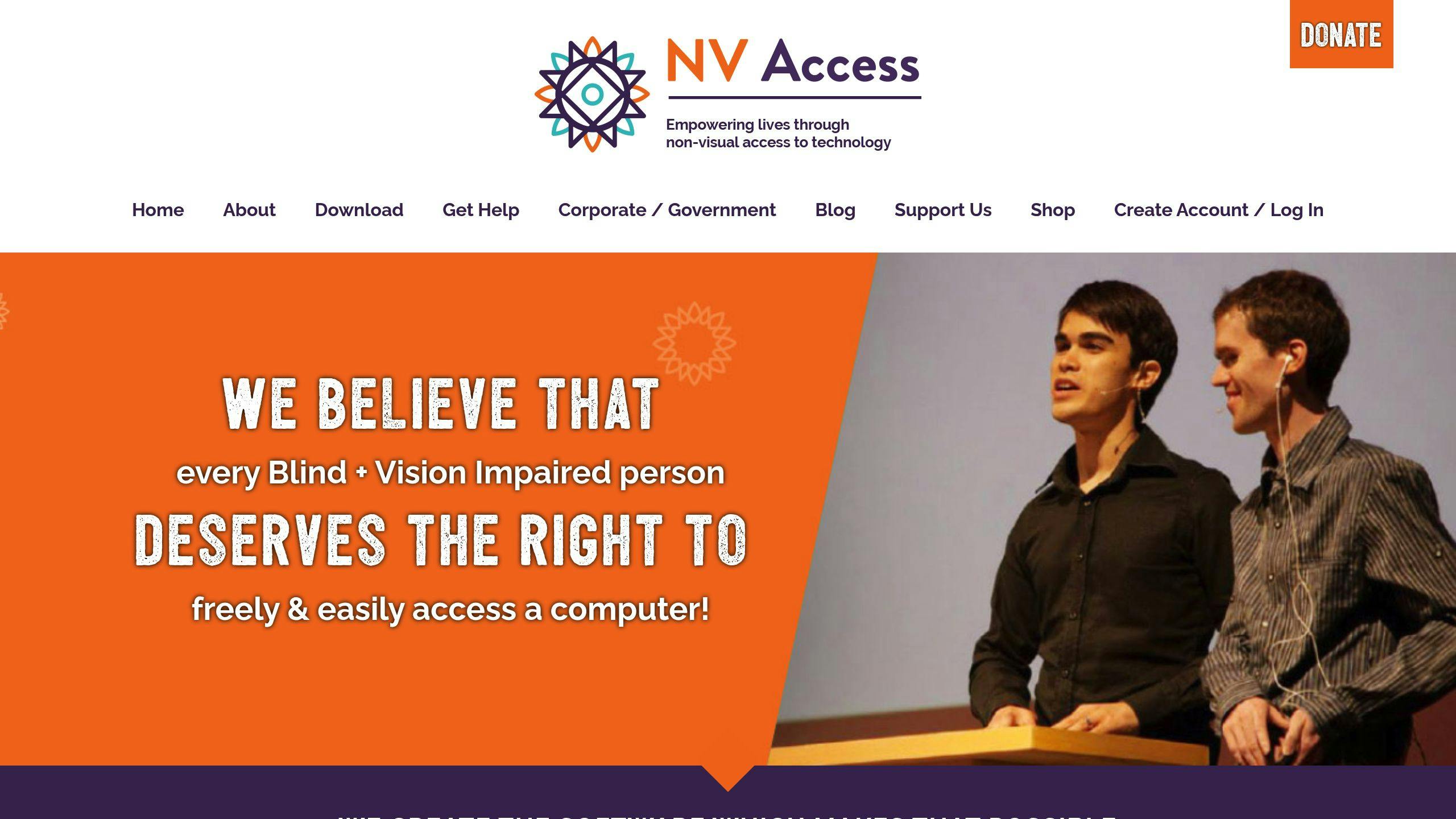Testing your website with screen readers ensures it’s usable for everyone, including visually impaired users. Screen readers convert on-screen text into speech or Braille, helping users navigate and interact with digital content. Here’s a quick guide to get started:
- Why It Matters: Accessible websites improve user experience, expand your audience, and reduce legal risks.
- Top Screen Readers:
- Key Testing Steps:
- Check navigation (headings, skip links, focus order).
- Test images (alt text for meaning or decorative exclusion).
- Validate forms (labels, error handling).
- Evaluate dynamic elements (modals, live updates).
- Tools & Setup: Use an updated OS, browser, and screen reader. Learn basic commands like reading headings and navigating links.
Quick Comparison of Screen Readers
| Feature | JAWS | NVDA | VoiceOver |
|---|---|---|---|
| Cost | Paid | Free | Free (Apple) |
| Platform | Windows | Windows | macOS/iOS |
| ARIA Support | Extensive | Good | Good |
| Dynamic Content | Advanced handling | Basic support | Integrated |
| Updates | Regular (Paid) | Regular (Free) | System updates |
Start by setting up your environment, testing key accessibility features, and addressing issues like missing labels or improper focus. Regular testing ensures your website remains accessible and user-friendly.
Accessibility Testing with the NVDA Screenreader

Choosing Screen Reader Software
Picking the right screen reader software is key to effective accessibility testing. Knowing your tools helps ensure thorough testing across different platforms.
Main Screen Reader Tools
- JAWS: Known for its advanced ARIA testing capabilities.
- NVDA: A free option for Windows users.
- VoiceOver: Pre-installed on Apple devices.
Using the right tool helps identify accessibility challenges accurately, which is essential for creating inclusive digital experiences.
Selection Criteria
When evaluating screen readers, keep these factors in mind:
| Criterion | Description | Impact |
|---|---|---|
| OS and Browser Compatibility | Works with specific operating systems and browsers | Defines the range of testing environments |
| Advanced Features | Handles ARIA and dynamic content | Impacts how deeply and precisely you can test |
| Cost Structure | Paid vs. free options | Affects budget planning |
| Learning Curve | Ease of use and available documentation | Influences team adoption and efficiency |
| Update Frequency | Frequency of updates and maintenance | Ensures alignment with current standards |
Tool Comparison Chart
Experts suggest using multiple screen readers to check compatibility across platforms. Here’s how the main tools compare:
| Feature | JAWS | NVDA | VoiceOver |
|---|---|---|---|
| Cost | Paid license required | Free | Free with Apple devices |
| Platform | Windows | Windows | macOS/iOS |
| ARIA Support | Extensive | Good | Good |
| Dynamic Content | Advanced handling | Basic support | Integrated support |
| Updates | Regular (paid) | Regular (free) | Tied to system updates |
| Professional Support | Available | Community-based | Apple Support |
Your choice should align with your testing goals, audience, and technical environment. Consider your team’s expertise, budget, and specific project needs when deciding.
Once you’ve chosen your tools, the next step is setting up your testing environment for thorough accessibility evaluation.
Setting Up for Testing
Creating the right testing environment is key to accurately evaluating screen reader accessibility. A proper setup helps you achieve results that mirror real user experiences.
Test Environment Setup
Make sure your workspace includes the following:
| Component | Requirements |
|---|---|
| Hardware | A computer with a keyboard and headphones |
| Operating System | Latest stable version of Windows or macOS |
| Screen Reader | Your selected accessibility software |
| Web Browser | Updated version of Chrome, Firefox, or Safari |
Test the screen reader and system audio to confirm they work properly. Use headphones to replicate the auditory experience of users who rely on screen readers.
Once everything is set up, take time to learn the basic commands for your chosen screen reader. This will ensure you’re prepared for effective testing.
Basic Commands Guide
Here are some key commands for popular screen readers:
| Action | JAWS | NVDA | VoiceOver |
|---|---|---|---|
| Read Current Line | Insert + Up Arrow | NVDA + L | VO + L |
| Navigate Headings | H | H | VO + Command + H |
| List All Links | Insert + F7 | NVDA + F7 | VO + U |
| Form Fields | F | F | VO + Tab |
| Stop Reading | Control | Control | Control |
Testing Checklist
Once your environment is ready, use this checklist to ensure you’re covering all critical accessibility features:
1. Document Structure
Check that HTML language attributes and semantic markup are correct. Confirm the heading hierarchy flows logically from H1 to H6.
2. Navigation Elements
Test main navigation menus, skip links, and landmark regions. Ensure the keyboard focus is clearly visible and follows a logical tab order.
3. Content Components
Evaluate these key elements:
- Alt text and image descriptions
- Form labels and error messages
- Table headers and relationships
- Link purpose and clarity
- Updates to dynamic content
- Accessibility of modal dialogs and popups
4. Interactive Features
Ensure all interactive elements are keyboard-accessible, properly labeled, and provide clear feedback for state changes.
With this checklist, you’re ready to dive into detailed accessibility testing for your website.
Running Accessibility Tests
Now that your testing setup is ready, it’s time to assess your website’s accessibility using screen readers.
Navigation Testing
Check how users navigate your website using only a keyboard and screen readers.
| Navigation Element | What to Test | Success Criteria |
|---|---|---|
| Main Menu | Tab order, dropdown access | Clear focus indicators, proper announcements |
| Skip Links | Presence on the first tab stop | Announces "Skip to main content" |
| Interactive Elements | Buttons, links, controls | All elements are focusable and actionable |
| Focus Indicators | Visibility and contrast | Consistent and clear visual indication |
Heading Structure Review
Screen reader heading navigation helps ensure:
- There’s only one H1 heading per page.
- Headings follow a logical order.
- Section descriptions are accurate.
- Screen readers announce heading levels correctly.
Image Alt Text Testing
Verify that all images provide meaningful alt text or are ignored if purely decorative. Use screen reader commands to test:
- Informational images
- Complex visuals
- Image buttons
Form Testing
1. Label Association
Ensure every form field has a label that screen readers can announce accurately.
2. Error Handling
Submit incorrect data to confirm error messages are announced, focus shifts to the first error, and instructions for corrections are clear.
Dynamic Content Check
Test dynamic elements like modals and live updates to ensure they function well with screen readers. Key areas to evaluate include:
- Modal dialogs: Focus should remain trapped within the modal, and keyboard interactions should work seamlessly.
- Live updates: Use ARIA live regions to ensure updates are announced.
- Carousels: Verify keyboard control and the ability to pause.
- Expandable sections: Check that state changes are announced.
"Screen reader testing ensures users with visual impairments can access and navigate your website effectively, improving inclusivity." – Aayushi Verma, Community Contributor, BrowserStack
Pair manual screen reader testing with tools like BrowserStack Accessibility Testing for a thorough evaluation. Automated tools alone may miss some issues.
After completing these tests, review the results to determine which issues to address first.
sbb-itb-edfb666
Analyzing Test Results
Analyzing test results is a key step in turning findings into improvements for website accessibility.
Common Issues and Priority Ranking
Here’s a breakdown of common accessibility problems found during screen reader testing, their impact, and the urgency of addressing them:
| Issue Category | Common Problems | Impact | Priority & Response |
|---|---|---|---|
| Navigation Structure | Missing heading hierarchy, improper skip links | Disrupts navigation significantly | P1 – Fix within 1-2 weeks |
| Content Accessibility | Insufficient alt text, unlabeled buttons | Blocks essential functionality | P0 – Immediate fix required |
| Form Elements | Missing field labels, unclear error messages | Hinders data entry | P1 – Fix within 1-2 weeks |
| Dynamic Content | Content changes not announced to users | Affects user awareness | P2 – Fix within 1 month |
| Interactive Elements | Keyboard traps, non-functional ARIA | Prevents core interactions | P0 – Immediate fix required |
Once these issues are flagged, prioritize them based on their effect on user experience and functionality.
Test Results Report
A well-structured accessibility report should cover these key areas:
-
Executive Summary
- Outline the testing scope and pages reviewed.
- List the screen readers used during testing.
- Highlight key metrics and provide an overall accessibility score.
-
Detailed Findings
- Include the page URL.
- Describe how the screen reader behaved.
- Compare expected outcomes with actual results.
-
Recommendations
- Offer specific coding solutions or implementation steps for each identified issue.
"Expert insight is crucial for understanding the implications of test results and for providing actionable recommendations. Teams should focus on addressing critical issues that prevent users from accessing essential content or functionality first."
After prioritizing the issues, organize the findings into a clear report to guide the remediation process.
Maintaining Accessibility
Keeping accessibility up to date is an ongoing effort that builds on the testing strategies discussed earlier.
Testing Schedule Setup
Coordinate your testing schedule with development cycles to ensure accessibility remains a priority:
| Testing Frequency | Activities | Tools/Methods |
|---|---|---|
| Weekly | Quick navigation checks | NVDA, VoiceOver |
| Monthly | Comprehensive page audits | BrowserStack Accessibility Testing |
| Quarterly | Full site assessment | Multiple screen readers + manual testing |
| After Updates | Feature-specific testing | Tool combinations based on changes |
Having a structured schedule is only half the battle – your team also needs the skills to carry out effective testing.
Team Training Guide
A well-trained team is essential for maintaining accessibility, especially when it comes to screen reader testing.
Core Skills to Develop
- Learning how to use screen reader commands effectively
- Checking the accessibility of headings and forms
- Evaluating how dynamic content behaves for users
Hands-On Practice
Incorporate real website components into training exercises. Encourage team members to use various screen readers to understand different user experiences. Platforms like BrowserStack offer tools for thorough testing, making them a great resource for training sessions.
Staying up to date with accessibility standards is equally important for ensuring compliance over time.
Standards Updates
Stay informed about changes in accessibility requirements through reliable channels:
Key Resources for Updates
- WCAG guidelines and related technical documents
- Updates from screen reader software
- Discussions in industry accessibility forums
"Ongoing learning is vital for maintaining accessibility. Teams should regularly review accessibility standards and implement new guidelines promptly to ensure ongoing compliance with evolving requirements."
How to Stay Compliant
Regularly monitor trusted sources for updates and integrate new standards into your processes systematically. Tools like JAWS Inspect can help streamline testing, providing clear reports to track your progress over time.
Conclusion
Screen reader testing plays a key role in ensuring websites are accessible, enhancing user experience and meeting compliance requirements. Regular testing and updates help maintain accessibility over time.
Testing Steps Overview
Screen reader testing uses a mix of automated tools and manual checks. The main areas to focus on include:
| Testing Area | Key Focus Points |
|---|---|
| Navigation | Site structure, keyboard usage |
| Content | Headings, alt text, forms |
| Dynamic Elements | AJAX updates, popups |
| Documentation | Issue tracking, resolution |
By addressing these areas, you can take meaningful steps toward creating a more accessible digital experience.
Next Steps
Start by assessing your website’s accessibility, tackle the most pressing issues, and schedule regular testing. Training your team ensures accessibility becomes a consistent part of your workflow.
Kreativa Inc Accessibility Audit

If you need expert assistance, Kreativa Inc provides usability and SEO audits with a focus on screen reader compatibility. Their services pinpoint accessibility challenges and offer practical solutions aligned with current standards.
"Ongoing learning is vital for maintaining accessibility. Teams should regularly review accessibility standards and implement new guidelines promptly to ensure ongoing compliance with evolving requirements."
FAQs
These FAQs address common challenges in screen reader testing, offering practical solutions for better implementation of the techniques discussed in this guide.
How can I determine if a website works well with screen readers?
Websites compatible with screen readers need clear heading structures, descriptive alt text, and properly labeled form fields. Regular testing with screen readers helps ensure both compliance and usability.
"The most effective method of ensuring web accessibility is a combined approach of designing clear, simple content, regularly testing your web pages with automated tests and screen readers and following the principles of WCAG across the entirety of your website."
After confirming your website’s structure supports screen readers, the next step is identifying specific accessibility issues.
How can I identify screen reader accessibility issues?
To find potential issues, test navigation elements like ‘skip to main content’ links and evaluate compatibility using multiple screen readers. Pay special attention to NVDA and JAWS, as they are widely used by screen reader users globally.
Once you’ve identified potential concerns, move on to thorough testing of your website.
How do I test my website for screen reader compatibility?
Testing involves checking navigation, form usability, updates to dynamic content, and multimedia descriptions. Use tools like NVDA or VoiceOver for manual testing, combined with automated checks. Key areas to evaluate include:
- A clear and consistent structure
- Accessible form fields
- Proper announcements for dynamic content
- Accurate descriptions for multimedia
"The most effective method of ensuring web accessibility is a combined approach of designing clear, simple content, regularly testing your web pages with automated tests and screen readers and following the principles of WCAG across the entirety of your website."


